ISSN ONLINE(2319-8753)PRINT(2347-6710)
ISSN ONLINE(2319-8753)PRINT(2347-6710)
Madhusudhan1, B.P.Mahesh2, Prabhushankar.M.R3
|
| Related article at Pubmed, Scholar Google |
Visit for more related articles at International Journal of Innovative Research in Science, Engineering and Technology
Automation of the devices had resulted in the significant improvement of accuracy of the output simultaneously reducing the manual involvement. RADAR borne vehicles play a vital role in a system designated to provide national security. The antenna of radar needs to be adjusted horizontally before it goes into operation. The delay in the beginning of RADAR’s function will temporarily shut down the systems which are completely dependent on Radar’s instructions. Also Radar borne vehicle should function successfully providing the desired levelling at different topological conditions like river banks, desert areas and rocky surfaces also with extreme temperature differences without delay and making no compromise in the levelling accuracy. The present study provides automated and simplified levelling system to aid the levelling of the vehicle simultaneously reducing the manual involvement & effort. Basic study was conducted with different available jacks, their functional capabilities also the problem associated with them. Based on the input obtained and desired needs of the customer many conceptual solutions were generated out of which the promising one was carried forward for further design & development. Electro-Mechanical jack system of levelling was found to be suitable for the problem
Keywords |
| Automation, Horizontal levelling, Topology |
I. INTRODUCTION |
| Jack: A jack is a mechanical device used as a lifting device to lift heavy loads or apply great forces. A mechanical jack is a device which is used to lift heavy equipment more powerful jacks use hydraulic power to provide more lift over greater distances. Jacks are also used in vehicles such as cranes to lift the vehicle & prevent it from moving. Screw type mechanical jacks were very common for jeeps and trucks of World War II vintage. These jacks were activated by using the lug wrench as a handle for the jack's ratchet action of the jack. Screw type jack's continued in use for small capacity requirements due to low cost of production involved to raise or lower it. |
| RADAR: RADAR stands for Radio Detecting and Ranging and as indicated by the name, it is based on the use of radio waves. Radars send out electromagnetic waves similar to wireless computer networks and mobile phones. The signals are sent out as short pulses which may be reflected by objects in their path, in part reflecting back to the radar. When these pulses intercept precipitation, part of the energy is scattered back to the radar. |
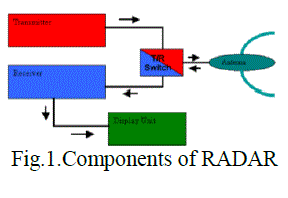 |
| Electro-Mechanics: Electro mechanics is a combination of Electrical and mechanical processes and procedures drawn from mechanical engineering and Electrical engineering Electrical engineering in this context also encompasses Electronics engineering. Devices which carry out electrical operations by using moving parts are known as electromechanical. A manually operated switch is an electromechanical component. |
II. METHODOLOGY |
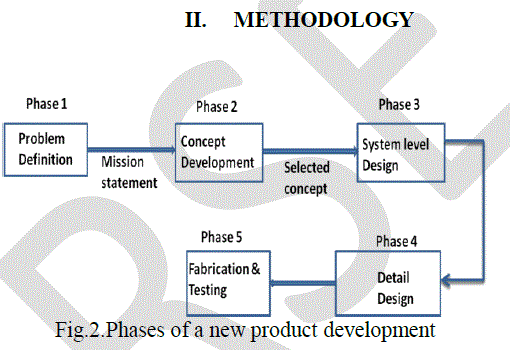 |
STATEMENT OF THE PROBLEM |
| Efficient functioning of the radar requires horizontal levelling nearly equal to the water level. Improper levelling leads to false location of targets. In many situations there will be less time and the levelling needs to be achieved quickly. Manual interpretation and manual effort in achieving the levelling should be minimized or reduced. It should not fail due to temperature gradients. |
| Objectives of the project |
| The main objective of the project is to provide an effective and simplified levelling device for use in a vehicle levelling and support system of RADAR borne vehicles. More specifically this invention contemplates the provision of a system for a levelling device useful in levelling and supporting a parked vehicle. |
| To provide a levelling system that accomplish for manual override in the event that one or more of the electrical motors for driving the system becomes in operative or the electrical source is unavailable. |
Concept Development |
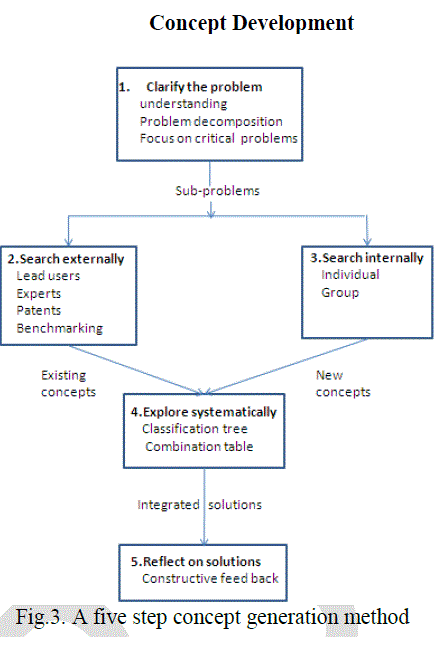 |
| A product concept is an approximate description of the technology working principles and form of the product. It is a concise description of how the product will satisfy the customer needs. Fortunately concept generation is relatively inexpensive and can be done relatively quickly in comparison to the rest of the development process. |
| Concept Selection |
| Concept selection is an integral part of the concept development process. Concept selection is the process of evaluating concepts with respect to customer needs and comparing the relative strengths and weaknesses of the different concepts and selecting one or few concepts for further developmental activities. A selection matrix was prepared to evaluate and rate different product concepts. The selection matrix reflected the needs & requirements of the customer. The needs of the customer are listed down in the selection matrix. Based on care full evaluation of all the concepts the most promising one was carried forward. |
| Detailed Design |
| The detail design phase includes the complete specification of the geometry, materials & tolerances of all the unique parts of the product. This process also identifies the standard parts to be purchased from the customers. The output of this phase is the control documentation for the product-the drawings or the computer files describes the geometry of the part. |
| The detailed design phase was carried out according to the flow diagram shown in Fig.4. |
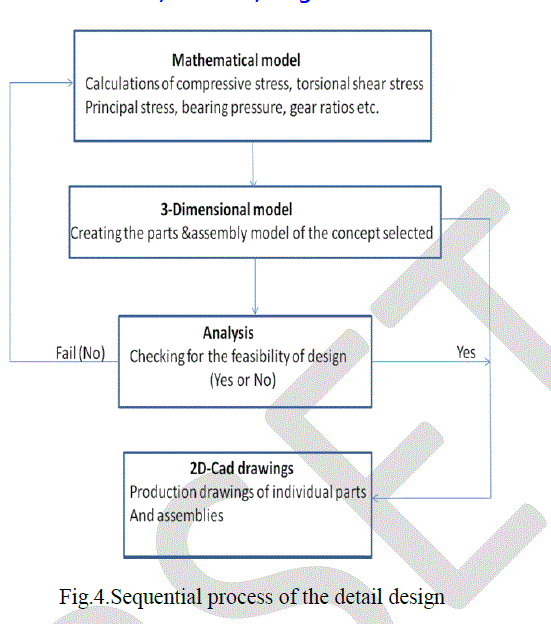 |
| Mathematical model |
| The mathematical model involves the calculation of stress, bearing pressure, gear ratio etc. The load each jack needs to lift was considered to be the main data based on that all other design calculations & part geometry calculations were made. |
| Analysis of the product structure |
| The inner sleeve with resting pad assembly was considered for meshing and analysis because the outer sleeve is a closure for the inner sleeve and does not subjected to loading. Using Hyper mesh V11.0 the model was meshed and the desired load was applied, and no deformation was noticed which signified the safe design |
III. FABRICATION & TESTING |
| The entire assembly was divided into 3 sub assemblies and each sub-assembly into parts, which made the fabrication and assembly easy. Appropriate materials were selected for the parts based on their function. Required tolerances were provided to the part geometry dimensions to achieve the desired functional requirement. The raw materials were processed through a series of sequential operations to obtain the final geometry of the part. |
| Testing |
| Load Bearing capacity of Jacks |
| The test bench was provided with the appropriate mounting facility for the jack. The jack will be mounted in the horizontal position on the test bench. A strain gauge is used to check for the load applied and the strain gauge is provided with a digital display to check the load applied. The load was applied manually through the connecting shaft with the help of the spanner key made for the jacks. The inner sleeve extends outwards gradually and touches the strain gauge. When the resting pad of the jack just touches the strain gauge the load is zero, as the sleeve continues to move outward the load increases. In this way the sleeve was moved out until the load reaches 12,000kg in the strain gauge. With the load applied the set-up was left for a period of 2hrs. And no retraction or any deformation was noticed. |
IV. CONCLUSION |
| There has been a growing interest for the automation of the present day systems on account of their outstanding performance, reduced manual interpretation, increased accuracy and less time involved in accomplishing the task. The present work is dedicated to the design development of an automated levelling system for the RADAR borne trucks. |
| The control system based on Electro-Mechanical principle facilitates the levelling system to function effectively at inclement weather conditions. The use of servo mechanism and level sensors to aid the levelling system were helpful in achieving the desired accuracy level. The stroke length of each jack was sufficient enough in achieving the horizontal levelling at all topological conditions. The entire operation is controlled by an electrically- operated control panel, when electrical supply fails or not provided the jacks can be operated manually. With properly designed mounting brackets to the jacks and minor modifications to the vehicle the designed levelling system can be used for existing vehicles also. |
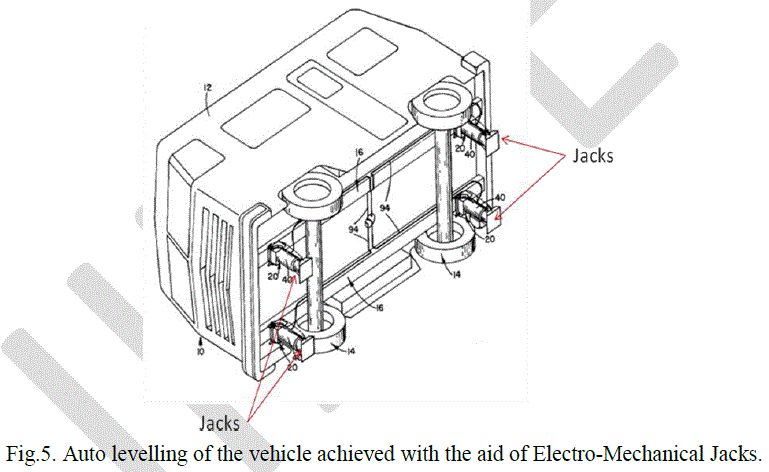 |
References |
|